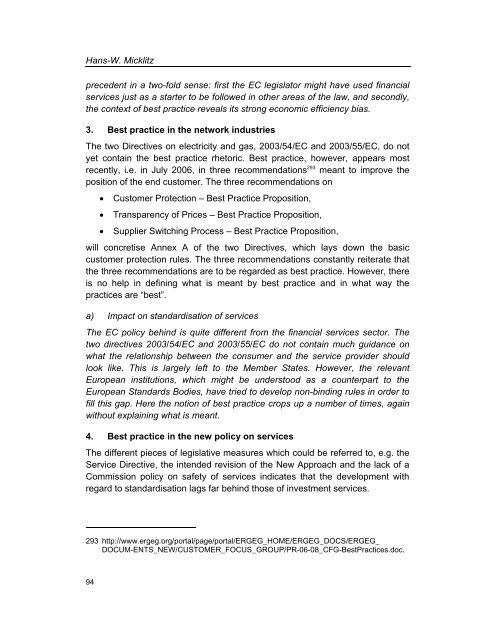Services Standards: Defining the Core Consumer Elements ... - ANEC
Services Standards: Defining the Core Consumer Elements ... - ANEC
Services Standards: Defining the Core Consumer Elements ... - ANEC
Create successful ePaper yourself
Turn your PDF publications into a flip-book with our unique Google optimized e-Paper software.
Hans-W. Micklitz<br />
precedent in a two-fold sense: first <strong>the</strong> EC legislator might have used financial<br />
services just as a starter to be followed in o<strong>the</strong>r areas of <strong>the</strong> law, and secondly,<br />
<strong>the</strong> context of best practice reveals its strong economic efficiency bias.<br />
3. Best practice in <strong>the</strong> network industries<br />
The two Directives on electricity and gas, 2003/54/EC and 2003/55/EC, do not<br />
yet contain <strong>the</strong> best practice rhetoric. Best practice, however, appears most<br />
recently, i.e. in July 2006, in three recommendations 293 meant to improve <strong>the</strong><br />
position of <strong>the</strong> end customer. The three recommendations on<br />
• Customer Protection – Best Practice Proposition,<br />
• Transparency of Prices – Best Practice Proposition,<br />
• Supplier Switching Process – Best Practice Proposition,<br />
will concretise Annex A of <strong>the</strong> two Directives, which lays down <strong>the</strong> basic<br />
customer protection rules. The three recommendations constantly reiterate that<br />
<strong>the</strong> three recommendations are to be regarded as best practice. However, <strong>the</strong>re<br />
is no help in defining what is meant by best practice and in what way <strong>the</strong><br />
practices are “best”.<br />
a) Impact on standardisation of services<br />
The EC policy behind is quite different from <strong>the</strong> financial services sector. The<br />
two directives 2003/54/EC and 2003/55/EC do not contain much guidance on<br />
what <strong>the</strong> relationship between <strong>the</strong> consumer and <strong>the</strong> service provider should<br />
look like. This is largely left to <strong>the</strong> Member States. However, <strong>the</strong> relevant<br />
European institutions, which might be understood as a counterpart to <strong>the</strong><br />
European <strong>Standards</strong> Bodies, have tried to develop non-binding rules in order to<br />
fill this gap. Here <strong>the</strong> notion of best practice crops up a number of times, again<br />
without explaining what is meant.<br />
4. Best practice in <strong>the</strong> new policy on services<br />
The different pieces of legislative measures which could be referred to, e.g. <strong>the</strong><br />
Service Directive, <strong>the</strong> intended revision of <strong>the</strong> New Approach and <strong>the</strong> lack of a<br />
Commission policy on safety of services indicates that <strong>the</strong> development with<br />
regard to standardisation lags far behind those of investment services.<br />
293 http://www.ergeg.org/portal/page/portal/ERGEG_HOME/ERGEG_DOCS/ERGEG_<br />
DOCUM-ENTS_NEW/CUSTOMER_FOCUS_GROUP/PR-06-08_CFG-BestPractices.doc.<br />
94
















